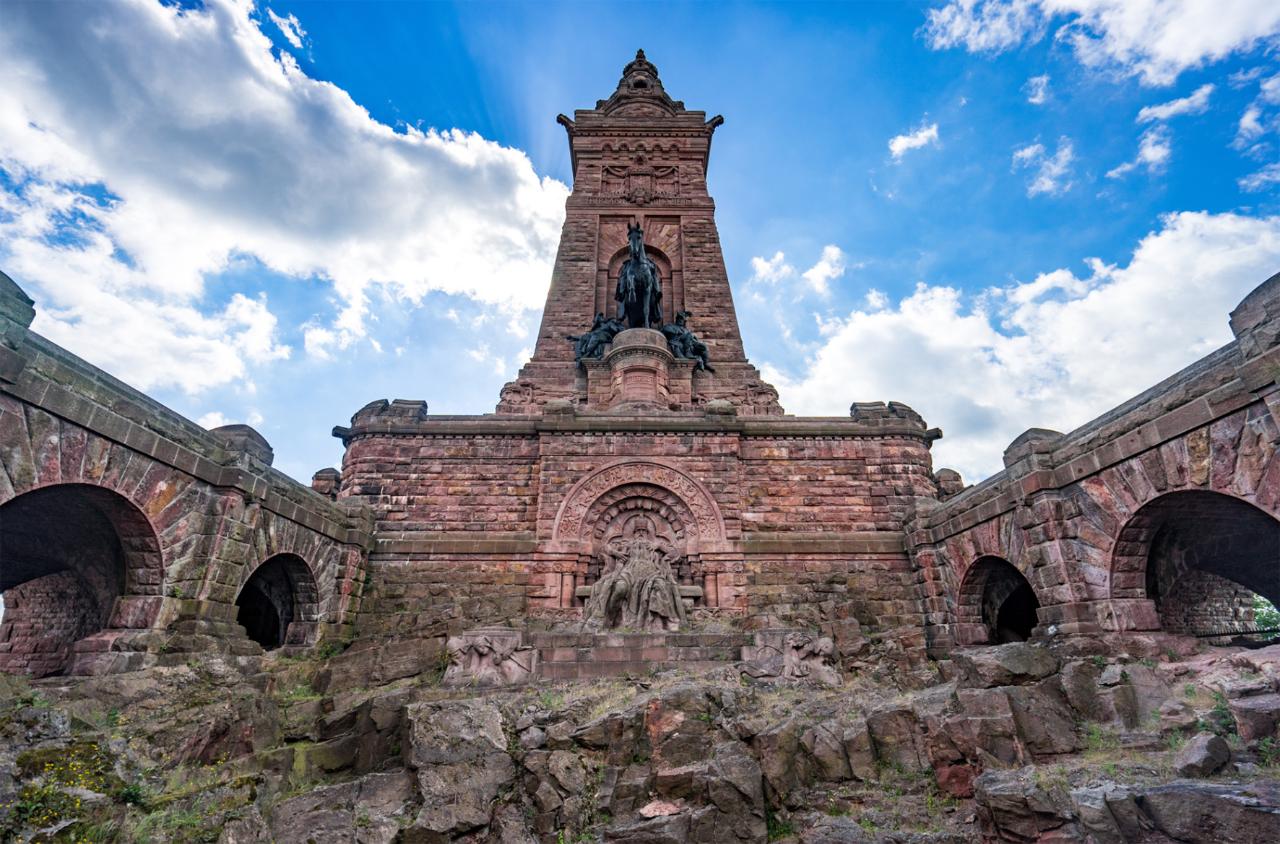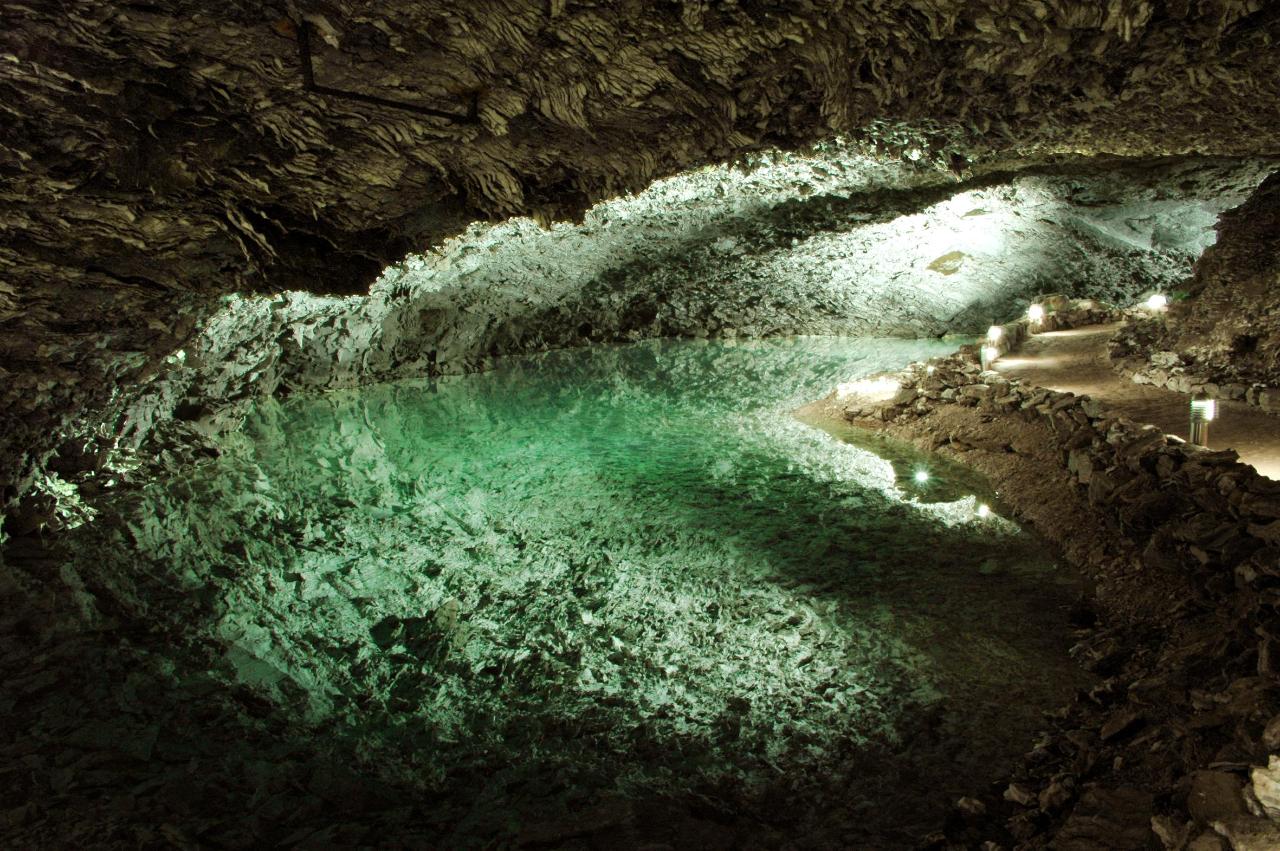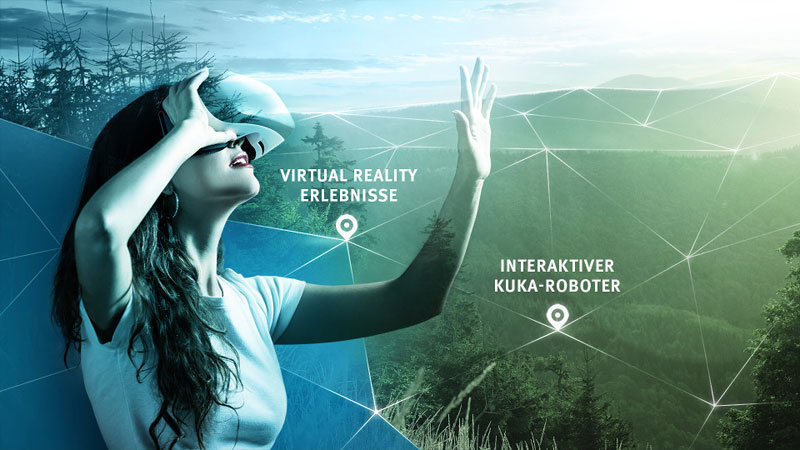Visit the state capital Erfurt and go on a virtual discovery tour through Thuringia.
In a land before time
The Kyffhäuserweg trail
Maybe, this is how it happened: On a warm spring day in 1896, in May or even a little later, in early June, a day hot enough to make you sweat and the air shimmer, swallows are flying their figures of eight in the sky above the Kyffhäuser. Up by the monument, the Bavarian workmen are treating themselves to a beer brewed in their home town of Munich. Finished! At last! They have spent weeks and weeks riveting prefabricated copper sheets together until the statue was completed, and now he is up there on top of the monument at last, the German Emperor William I on horseback. All they have to do now is to tidy up after themselves. They don't know where to leave their empties, so the workers simply put the bottles inside the still-open hoof of the statue's horse. Where they were then found behind the cover during restoration works in 2013, 117 years later. This story is written on a board inside the tower, and two hikers are standing in front of the board. "It beggars belief!", says the woman and loosens her backpack straps, "To think that they brought their own beer with them all the way from Bavaria!" She shakes her head. From Bavaria. Ridiculous, seeing that there is such good beer to be had in Thuringia. "Let's have a drink before we go on," her husband adds.
The Kyffhäuser!
A hill range steeped in legend! Full of secrets and mysteries! According to one of these legends, Emperor Barbarossa has been fast asleep deep inside the Kyffhäuser for the past 800 years, and who knows what treasures the lords of Kyffhausen Castle hid in the woods in the Middle Ages, when they were besieged by enemies? Aren't they still searching for their stash of gold and silver even in the deep well of the old fortress? One thing is certain: Even if you are only familiar with some of the stories surrounding Thuringia's most famous hill - you won't like hiking here on your own, as the whispers of the past are everywhere.
With a total length of 37 kilometres, the Kyffhäuserweg trail is the most beautiful approach to this hill of myths and legends. Right from the start in Bad Frankenhausen, where most hikers set off on the tour, taking two or three days to complete it: Lovely, quiet streets, small cafés and restaurants with outdoor areas where you can breakfast in the morning and finish the day with a beer in the evening.
The trail leads westwards from Bad Frankenhausen, but before setting off, a quick look at Oberkirche church, or rather, its tower, is a must, of course. It started to lean sideways, millimetre by millimetre, nobody knows when, and has long since held the record of being Germany's most lopsided church tower. After that, a quick visit to the Panorama Museum – and then off you go. Onto the Kyffhäuserweg trail. Into the forest.
Geologically speaking, the Kyffhäuser is not actually a hill at all but a small complete range of hills, 12.5 kilometres long and 5.5 kilometres across. With heights of around 400 metres, sometimes more, sometimes less, the hills tower over the flat countryside as if they wanted to show everyone that you don't have to be huge to look like a proper mountain range. Or, incidentally, to feel like one: There are passages along the Kyffhäuserweg trail that are quite challenging, leading pretty steeply upwards one minute and then down again the next, and then upwards again. The reward for this effort is the panorama: The plain with fields you look down on during the first stage of the hike is called "Diamantene Aue", the diamond valley wetlands. Further along the Kyffhäuserweg trail, in the north, you then look down on the "Goldene Aue", the golden valley wetlands. Names like these also contribute to the fact that you sometimes feel as if you were hiking through a land that time forgot.
Frederick I, King of Germany, Holy Roman Emperor ("Barbarossa", Redbeard) and head of the Hohenstaufen dynasty, drowned in Asia Minor – in what is now Turkey – on the way to Jerusalem on 10 June 1190. He would remain the only mediaeval emperor whose exact grave location is unknown – which led to wild speculations, rumours and stories even as far back as in the Middle Ages. To this day, nobody knows whether there is a grain of truth in them. Later on, the Kyffhäuser legend probably came about in the same way: It was rumoured that Barbarossa was not dead after all – but merely fast asleep on a throne deep inside the Kyffhäuser. In 1817, the German linguist and poet Friedrich Rückert penned a famous poem that retold the legend of Barbarossa having "taken the empire's glory" with him into the depths of the Kyffhäuser. Every hundred years, according to the legend, Barbarossa wakes briefly and sends a dwarf up to the surface to have a look at the lie of the land, and if the old ravens are still circling there, he must continue his enchanted sleep.
Never mind that it is actually possible to go inside the Kyffhäuser. Wouldn't you agree that the Barbarossa cave really is a mythical place? By torchlight, you can discover subterranean lakes whose surfaces reflect the ceiling, and if you look at them long enough, you really won't be able to tell what is real and what is merely a reflection, try as you might. By the way, the cave is particularly popular with acoustics specialists. As the surface of the ceiling is hugely increased through hundreds of thousands of suspended natural gypsum formations, there is neither any resonance nor an echo. Even Barbarossa himself could move about completely silently here.
Outside in the woods
The tweeting of birds. The drumming of a woodpecker. The hum of bumble bees. The wind rustles through the leaves in the treetops; all you can hear is the forest, the creaking of the trees, the whispering grass. That's another thing that makes the Kyffhäuser so special: Because it is so different and stands out clearly from the surrounding countryside, it sometimes feels like a small parallel, self-contained universe. A world through which you can hike in peace and quiet. The Kyffhäuserweg trail is not a mass tourism destination. From time to time, you'll meet other hikers walking in the opposite direction; you greet each other, they might enquire: "How far to go to the monument?". A couple of minutes later, you're alone again.
And then, the 360-degree panorama from the monument: Probably the most impressive to be had in Thuringia. What a view! You can see for miles and miles! It almost seems like right on the edge of the horizon, you can see the Earth curve.
The Kyffhäuserweg trail leads past many small, picturesque villages dotted all over the countryside.
First comes Kelbra. Then Sittendorf. Next is Tilleda, where you are planning to spend the night before continuing along the trail through the meadows and orchards on the eastern slopes of the Kyffhäuser on the following day. Back to Bad Frankenhausen. Maybe it's because of these panoramas. Maybe, the Kyffhäuser's secrets and mysteries remain undiscovered because your gaze is always drawn away from it, across the wetland valleys, the fields, towards the sky, the horizon. Maybe, you shouldn't always gaze into the distance – but rather pay attention to wherever you happen to be along this range of hills. After all, the empty beer bottles in the hoof of the emperor's horse were also there the whole time, but nobody looked closely enough.

It takes around three days to hike the complete trail along this range of hills that is surrounded by myths and legends. Athletic hikers also manage to complete the 37-kilometre circular trail in two days. The highlights along the trail include the Panorama Museum in Bad Frankenhausen, the Barbarossa cave, the Kyffhäuser Monument and ruins of a mediaeval castle, as well as the Königspfalz Tilleda, a mediaeval, fortified royal residence reconstructed by archaeologists from its ruins that is now an open-air museum. Tip: On request, the Kyffhäuser dial-a-bus service picks up tired hikers during the summer months. Image ©Gregor Lengler, Thüringer Tourismus GmbH
Header picture & Picture Infobox: ©Gregor Lengler, Thüringer Tourismus GmbH
Accessibility
Did you like this story?
You might also be interested in ...





















